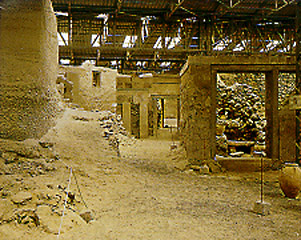|
museums
& archaeological sites
| ARCHAEOLOCICAL
MUSEUM OF SANTORINI |
| LOCATION:: FIRA
Telephone: +30-22860-22217
It was built in 1960 by the Ministry of Public Works in order to
replace the old museum (built in 1902), which had collapsed during
the earthquakes of 1956.
The Museum contains the following collections:
:: Sculpture, ranging from the Archaic to the Roman period.
:: Inscriptions, ranging from the Archaic to the Roman period.
:: Vases and clay figurines, dating from the Geometric to the Hellenistic
periods. |
| MUSEUM OF PREHISTORIC
THERA |
| The Museum of Prehistoric Thera houses finds from
the excavations at Akrtotiri, conducted under the auspices of the
Archaeological Society at Athens, the earlier excavations at Potamos,
made by members of the German Archaeological Institute at Athens,
and rescue excavations at various other sites on the island, carried
out by the 21st Ephorate of Antiquities for the Cyclades and Samos,
as well as objects discovered fortuitously or handed over.
Telephone: +30-22860-23.217 |
| ANCIENT THERA
|
| Ancient Thera, the Classical city of the island
is located on Mesa Vouno, 396 m. above sea level. It was founded
in the 9th century B.C. by Dorian colonists whose leader was Theras,
and continued to be inhabited until the early Byzantine period.
The preserved ruins belong to the Hellenistic and Roman phases of
the city. The residential area and the larger part of the cemeteries
were excavated by German archaeologists between 1895 and 1902. The
cemeteries on the NE and NW slopes of Sellada were excavated by
N. Zapheiropoulos in the years 1961-1982.
| |
|  acrotiri
of thera acrotiri
of thera
It is one of the most important prehistoric settlements
of the Aegean. The first habitation at the site dates from
the Late Neolithic times (at least the 4th millenium B.C.).
During the Early Bronze Age (3rd millenium B.C.), a sizeable
settlement was founded and in the Middle and early Late Bronze
Age (ca. 20th-17th centuries B.C.) it was extended and gradually
developed into one of the main urban centres and ports of
the Aegean.
The large extent of the settlement (ca. 20 hectares),
the elaborate drainage system, the sophisticated multi-storeyed
buildings with the magnificent wall-paintings, furniture and
vessels, show its great development and prosperity. The various
imported objects found in the buildings indicate the wide
network of its external relations. Akrotiri was in contact
with Crete but also communicated with the Greek Mainland,
the Dodecanese, Cyprus, Syria and Egypt.
The town's life came to an abrupt end in the
last quarter of the 17th century B.C. when the inhabitants
were obliged to abandon it as a result of severe earthquakes.
The erruption followed. The volcanic materials covered the
entire island and the town itself. These materials, however,
have protected up to date the buildings and their contents,
just like in Pompei. |
|
| OPENING HOURS
|
| SUMMER OPENING HOURS |
| Opening Hours for Archaeological Sites, Museums and Monuments
1 April - 31 October 2001
Monday: closed
Tuesday-Sunday: 08.30-15.00
Holidays
Holy Saturday, Easter Monday, Holy Spirit Day, 15 August:
08.30-15.00
Good Friday (until 12.00), Easter Sunday, 1st May: closed |
| WINTER OPENING HOURS |
| Opening Hours for Archaeological Sites, Museums and Monuments
1 November 2001 - 31 March 2002
Monday: closed
Tuesday-Sunday: 08.30-15.00
Holidays
- 6 January, Shrove Monday, Holy Saturday, Easter Monday,
Holy Spirit Day, 28 October: 08.30-15.00
- 1st January, 25 March, Good Friday (until 12.00), Easter
Sunday, 1st May, 25-26 December: closed
|
|
| |
|
